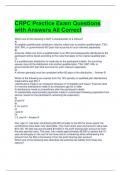CRPC Practice Exam Questions
with Answers All Correct
Which one of the following is NOT a characteristic of a rollover?
A)
An eligible qualified plan distribution may be rolled over to another qualified plan, TSA,
SEP, IRA, or governmental 457 plan that accounts for such rollovers separately.
B)
Amounts rolled over from a qualified plan to an IRA and subsequently distributed to the
participant will be taxed according to the rules that apply to the original qualified plan.
C)
If a qualified plan distribution is made due to the participant's death, the surviving
spouse may roll the distribution into another qualified plan, TSA, SEP, IRA, or
governmental 457 plan that accounts for such rollovers separately.
D)
A rollover generally must be completed within 60 days of the distribution. - Answer-B
Which of the following are exempt from the 10% penalty on qualified plan distributions
made before age 59½?
I.distributions made to an employee because of "immediate and heavy" financial need
II.in-service distributions made to an employee age 55 or older
III.distributions made to a beneficiary after the participant's death
IV.substantially equal periodic payments made to a participant following separation from
service, based on the participant's remaining life expectancy
A)
III and IV
B)
II, III, and IV
C)
I and III
D)
I, II, and IV - Answer-A
Dan, age 41, has been contributing $2,000 annually to his IRA for seven years; his
contributions have been fully deductible. The most recent year-end account value was
$18,100. He also has accumulated $16,800 in his profit sharing plan account at work;
the plan permits loans. This year, Dan needs approximately $5,000 to replace the 15-
year-old shingles on the roof of his home and is considering either withdrawing this
amount from his IRA or borrowing it from his profit sharing plan account.
Which one of the following best describes the potential tax liability from these two
options?
,A)
Withdrawing the funds from his IRA will result in a tax liability. Dan will be subject to
ordinary income tax and an early withdrawal penalty on the $5,000 withdrawal amount.
B)
Both options will result only in ordinary income taxation on the $5,000.
C)
Borrowing the funds from his profit sharing plan will result in a tax liability. Da - Answer-
A
Many retirees have difficulty dealing with Bengen's original safe initial withdrawal rate
because
A)
it does not provide adequate income.
B)
it is too risky for most people.
C)
it requires constant monitoring.
D)
for every $100,000, it generates only $10,000 of annual income. - Answer-A
When using the "bucket approach" to withdrawals from retirement savings, the "first"
bucket should be comprised of
A)
short-term, liquid investments.
B)
a diversified stock portfolio.
C)
intermediate- and long-term bonds.
D)
a mix of stock and bonds. - Answer-A
Mary Goodwin's financial situation is as follows:
Cash/cash equivalents $15,000
Short-term debts $8,000
Long-term debts $133,000
Tax expense $7,000
Auto note payments $4,000
Invested assets $60,000
Use assets $188,000
What is her net worth?
A)$111,000
B)$137,000
C)$122,000
D)$263,000 - Answer-C
, At the end of last year, Bill Greer has the following financial information:
Salaries$70,000Auto payments$5,000Insurance payments$3,800Food$8,000Credit
card balance$10,000Dividends$1,100Utilities$3,500Mortgage
payments$14,000Taxes$13,000Clothing$9,000Interest income$2,100Checking
account$4,000Vacations$8,400Donations$5,800
What is the cash flow surplus or (deficit) for Bill?
A)
$2,700
B)
$6,500
C)
$10,700
D)
($500) - Answer-A
Which of the following are correct statements about income replacement percentages?
I.Income replacement percentages are typically much higher for those with higher
preretirement incomes.
II.Income replacement percentages vary between low-income and high-income retirees.
III.Income replacement ratios should not be used as the only basis for planning.
IV.Income replacement ratios are useful for younger clients as a guide to their long-
range planning and investing.
A)
I and IV
B)
I and II
C)
II and III
D)
II, III, and IV - Answer-D
If Tom and Jenny want to save a fixed amount annually to accumulate $2 million by
their retirement date in 25 years (rather than an amount that grows with inflation each
year), what level annual end-of-year savings amount will they need to deposit each
year, assuming their savings earn 7% annually?
A)
$55,692
B)
$31,621
C)
$29,552
D)
$54,130 - Answer-B
Bill and Lisa Hahn have determined that they will need a monthly income of $6,000
during retirement. They expect to receive Social Security retirement benefits amounting




